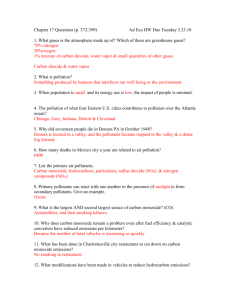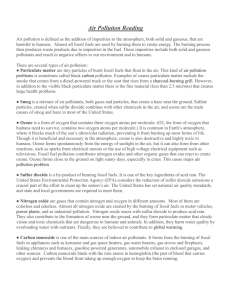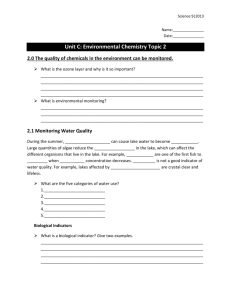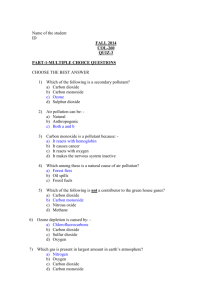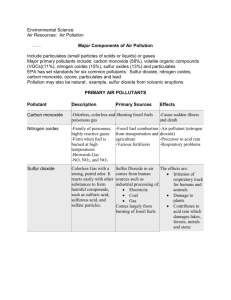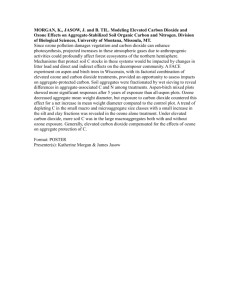Major Air Pollutants
advertisement
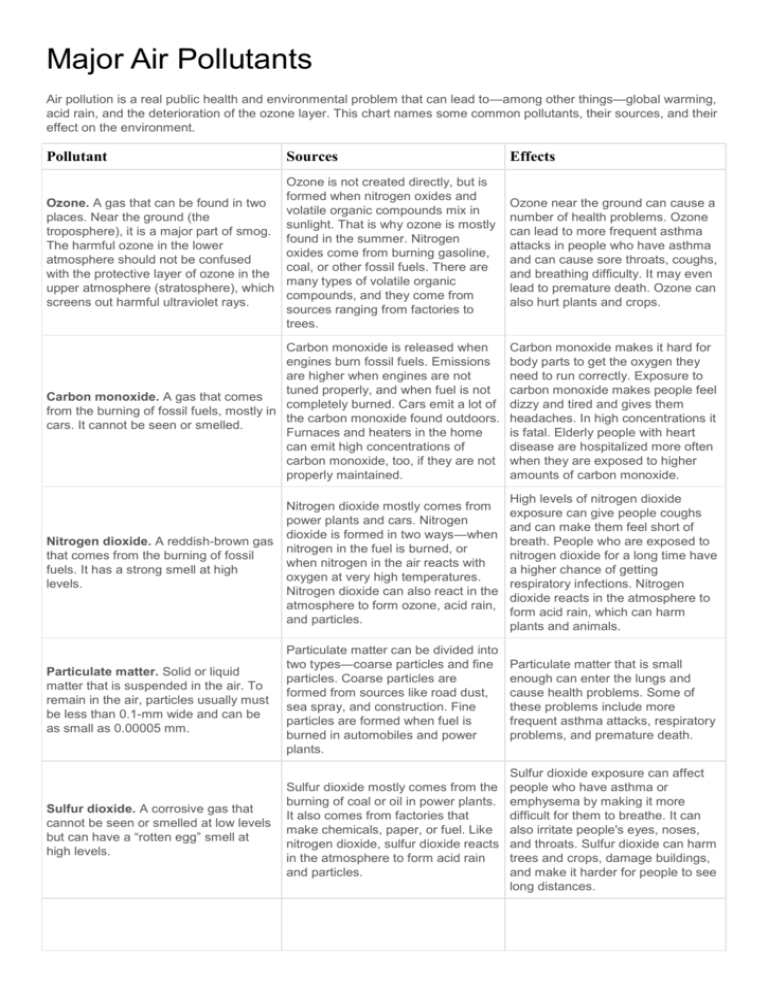
Major Air Pollutants Air pollution is a real public health and environmental problem that can lead to—among other things—global warming, acid rain, and the deterioration of the ozone layer. This chart names some common pollutants, their sources, and their effect on the environment. Pollutant Sources Effects Ozone is not created directly, but is formed when nitrogen oxides and Ozone. A gas that can be found in two volatile organic compounds mix in places. Near the ground (the sunlight. That is why ozone is mostly troposphere), it is a major part of smog. found in the summer. Nitrogen The harmful ozone in the lower oxides come from burning gasoline, atmosphere should not be confused coal, or other fossil fuels. There are with the protective layer of ozone in the many types of volatile organic upper atmosphere (stratosphere), which compounds, and they come from screens out harmful ultraviolet rays. sources ranging from factories to trees. Ozone near the ground can cause a number of health problems. Ozone can lead to more frequent asthma attacks in people who have asthma and can cause sore throats, coughs, and breathing difficulty. It may even lead to premature death. Ozone can also hurt plants and crops. Carbon monoxide is released when engines burn fossil fuels. Emissions are higher when engines are not tuned properly, and when fuel is not Carbon monoxide. A gas that comes completely burned. Cars emit a lot of from the burning of fossil fuels, mostly in the carbon monoxide found outdoors. cars. It cannot be seen or smelled. Furnaces and heaters in the home can emit high concentrations of carbon monoxide, too, if they are not properly maintained. Carbon monoxide makes it hard for body parts to get the oxygen they need to run correctly. Exposure to carbon monoxide makes people feel dizzy and tired and gives them headaches. In high concentrations it is fatal. Elderly people with heart disease are hospitalized more often when they are exposed to higher amounts of carbon monoxide. Nitrogen dioxide. A reddish-brown gas that comes from the burning of fossil fuels. It has a strong smell at high levels. Nitrogen dioxide mostly comes from power plants and cars. Nitrogen dioxide is formed in two ways—when nitrogen in the fuel is burned, or when nitrogen in the air reacts with oxygen at very high temperatures. Nitrogen dioxide can also react in the atmosphere to form ozone, acid rain, and particles. High levels of nitrogen dioxide exposure can give people coughs and can make them feel short of breath. People who are exposed to nitrogen dioxide for a long time have a higher chance of getting respiratory infections. Nitrogen dioxide reacts in the atmosphere to form acid rain, which can harm plants and animals. Particulate matter. Solid or liquid matter that is suspended in the air. To remain in the air, particles usually must be less than 0.1-mm wide and can be as small as 0.00005 mm. Particulate matter can be divided into two types—coarse particles and fine particles. Coarse particles are formed from sources like road dust, sea spray, and construction. Fine particles are formed when fuel is burned in automobiles and power plants. Particulate matter that is small enough can enter the lungs and cause health problems. Some of these problems include more frequent asthma attacks, respiratory problems, and premature death. Sulfur dioxide. A corrosive gas that cannot be seen or smelled at low levels but can have a “rotten egg” smell at high levels. Sulfur dioxide mostly comes from the burning of coal or oil in power plants. It also comes from factories that make chemicals, paper, or fuel. Like nitrogen dioxide, sulfur dioxide reacts in the atmosphere to form acid rain and particles. Sulfur dioxide exposure can affect people who have asthma or emphysema by making it more difficult for them to breathe. It can also irritate people's eyes, noses, and throats. Sulfur dioxide can harm trees and crops, damage buildings, and make it harder for people to see long distances. Lead. A blue-gray metal that is very toxic and is found in a number of forms and locations. Outside, lead comes from cars in areas where unleaded gasoline is not used. Lead can also come from power plants and other industrial sources. Inside, lead paint is an important source of lead, especially in houses where paint is peeling. Lead in old pipes can also be a source of lead in drinking water. Each toxic air pollutant comes from a slightly different source, but many are created in chemical plants or are Toxic air pollutants. A large number of emitted when fossil fuels are burned. chemicals that are known or suspected Some toxic air pollutants, like to cause cancer. Some important asbestos and formaldehyde, can be pollutants in this category include found in building materials and can arsenic, asbestos, benzene, and dioxin. lead to indoor air problems. Many toxic air pollutants can also enter the food and water supplies. High amounts of lead can be dangerous for small children and can lead to lower IQs and kidney problems. For adults, exposure to lead can increase the chance of having heart attacks or strokes. Toxic air pollutants can cause cancer. Some toxic air pollutants can also cause birth defects. Other effects depend on the pollutant, but can include skin and eye irritation and breathing problems. Stratospheric ozone depleters. Chemicals that can destroy the ozone in the stratosphere. These chemicals include chlorofluorocarbons (CFCs), halons, and other compounds that include chlorine or bromine. CFCs are used in air conditioners and refrigerators, since they work well as coolants. They can also be found in aerosol cans and fire extinguishers. Other stratospheric ozone depleters are used as solvents in industry. If the ozone in the stratosphere is destroyed, people are exposed to more radiation from the sun (ultraviolet radiation). This can lead to skin cancer and eye problems. Higher ultraviolet radiation can also harm plants and animals. Greenhouse gases. Gases that stay in the air for a long time and warm up the planet by trapping sunlight. This is called the “greenhouse effect” because the gases act like the glass in a greenhouse. Some of the important greenhouse gases are carbon dioxide, methane, and nitrous oxide. Carbon dioxide is the most important greenhouse gas. It comes from the burning of fossil fuels in cars, power plants, houses, and industry. Methane is released during the processing of fossil fuels, and also comes from natural sources like cows and rice paddies. Nitrous oxide comes from industrial sources and decaying plants. The greenhouse effect can lead to changes in the climate of the planet. Some of these changes might include more temperature extremes, higher sea levels, changes in forest composition, and damage to land near the coast. Human health might be affected by diseases that are related to temperature or by damage to land and water. The table below gives you more detailed information about air pollutants, their sources and how they effect you. Pollutant Particles (API) - Air Particle Index Source Nitrogen Dioxide (NO2) Human Health Effects Internal combustion engines (eg, cars and trucks); Industry (eg, factories); Burning wood; Cigarette smoke; and Bushfires. Long term exposure is linked to: Motor Vehicles are the biggest contributors; Other combustion processes; Exposure to high levels of NO2 may lead to: Lung Cancer; Heart Disease; Lung Disease; Asthma Attacks; and Other health problems. Lung damage; or Respiratory Disease. It has also been linked to: Ozone (O3) Formed by various complex chemical reactions involving the exposure of the oxides of nitrogen and some hydro-carbons. Ozone is the main ingredient of photochemical smog in summer and early autumn. Increased hospital admissions for asthma and respiratory problems; Increased mortality. Ozone effects the lining of the lungs; lining of the respiratory tract; and causes eye irritation. Ozone also damages plants, buildings and other materials. Carbon Monoxide (CO) Motor vehicle exhaust and burning of materials such as coal, oil and wood. It is also released from industrial processes and waste incineration When inhaled Carbon Monoxide enters the bloodstream and disrupts the supply of oxygen to the body’s tissues. A range of health effects may result depending on the extent of exposure. Lead (Pb) Is largely derived from the combustion of lead additives in motor fuels as well as lead smelting. Lead pollution from vehicle emissions is declining due to the introduction of unleaded fuels and reductions in lead levels in leaded fuel. Lead retards learning in children and the development of their nervous system; Lead effects almost every organ in the body, whether it is inhaled or ingested. Young children are particularly susceptible; Other atmospheric sources of lead include waste incineration and renovation of old houses (from leaded paint). Hydro-carbons (HC) chemical compounds composed of Hydrogen and Carbon atoms Most fuel combustion processes result in the release of hydro carbons to the environment. The largest fuel sources are natural gas and petrol. Note that hydrocarbons can enter the environment both as evaporative emissions from vehicle fuel systems, or in exhaust emissions. They are also a component of the smoke from wood fires. Exposure can cause headaches or nausea, while some compounds may cause cancer. Some may also damage plants.
